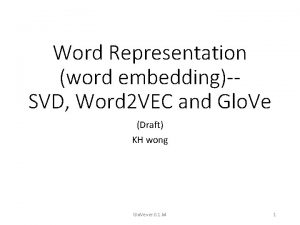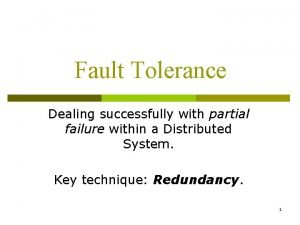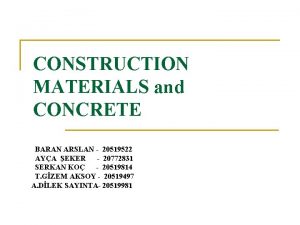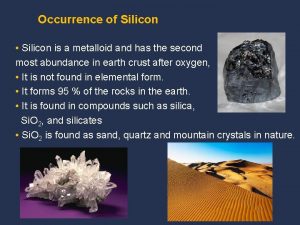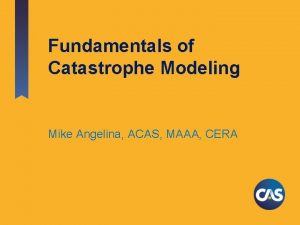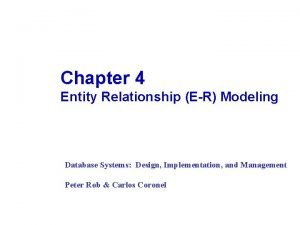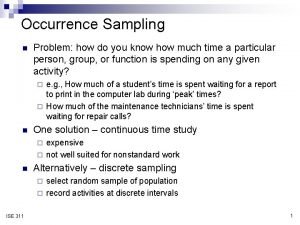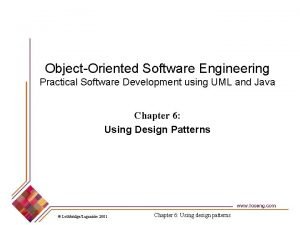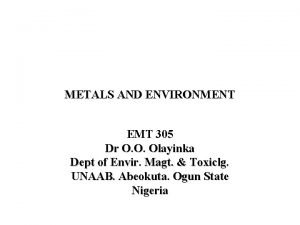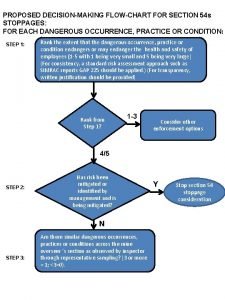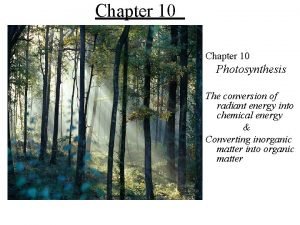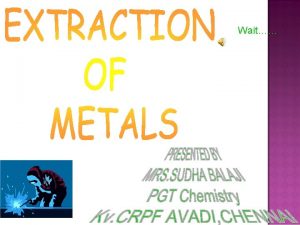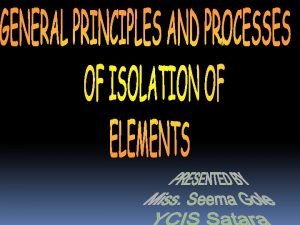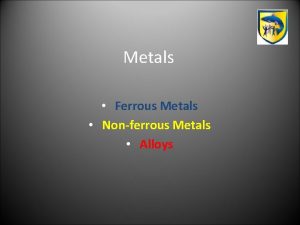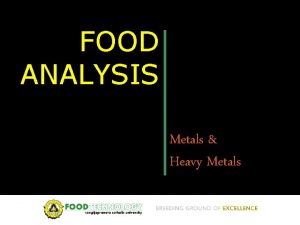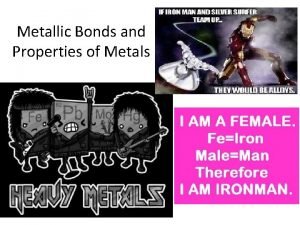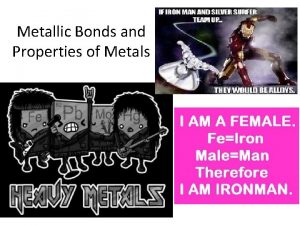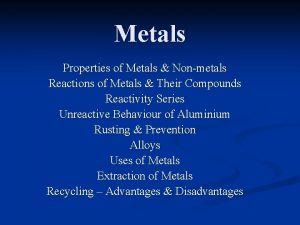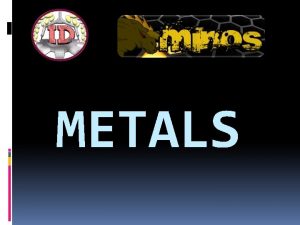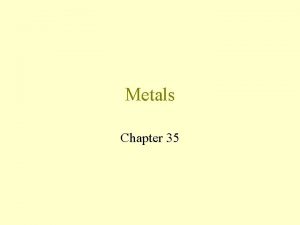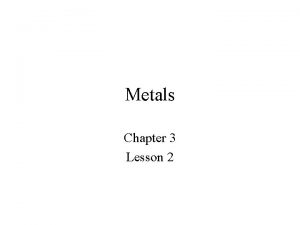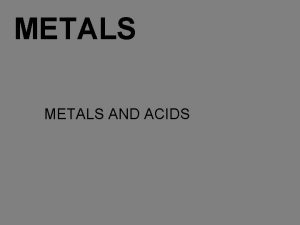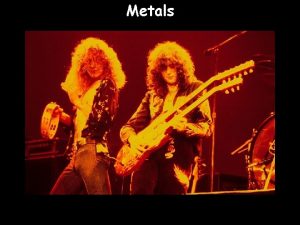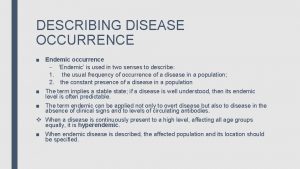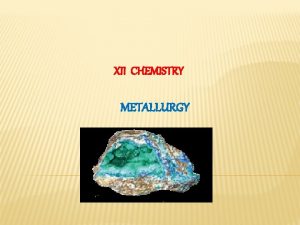Wait INTRODUCTION OCCURRENCE OF METALS THE MAJOR STEPS

































- Slides: 33

Wait……

INTRODUCTION OCCURRENCE OF METALS THE MAJOR STEPS USES CREDITS

For obtaining a particular metal, We look for minerals, which are naturally occurring chemical substances in the earth’s crust obtained by mining. Out of many minerals only a few are viable to be used as sources of metals. Such minerals are called ores. Ores are usually contaminated with earthly or undesired materials known as gangue. The entire scientific and technological process used for isolation of metal from it’s ores is known as METALLURGY.

The various metals, their ores, and composition are given below: METAL ORES COMPOSITION Aluminum Bauxite Kaolinite Al. Ox(OH)3 -2 x Al 2(OH)4 Si 2 O 5 Iron Haematite Magnetite Fe 2 O 3 Fe 3 O 4 Copper Pyrites Malachite Zinc Blende Calamine Cu. Fe. S 2 Cu. CO 3. Cu(OH)2 Zn. S Zn. CO 3 Zinc

The 3 major steps involved in extraction and isolation of metals from ores are as follows: ØCONCENTRATION OF ORES ØEXTRACTION OF METAL FROM CONCENTRATED ORE ØREFINING OF METAL

Removal of unwanted materials from the ore is known as concentration. On the basis of the type of ores, some of the important processes are given below: HYDRAULIC WASHING MAGNETIC SEPARATION FROTH FLOATATION LEACHING

Hydraulic washing is based on the differences in gravities of the ores and the gangue. In this process an upward steam of running water is used to wash the powdered ore. The lighter gangue particles are washed away and the heavier ores are left behind.

Magnetic separation is based on differences in magnetic properties of the ore components. If either the or the gangue is capable of being attracted by a magnetic field, then such separations are carried out. The ground ore is carried on a conveyer belt Click here to see which passes over a magnetic roller. the animation

Powdered ore Magnetic Roller Leather belt Magnetic ore Non-magnetic impurities Click to Start

This method is being used for removing gangue from sulphide ores. In this process, a suspension of the powdered ore is made with water. To it, collectors and froth stabilisers are added. The mineral particles become wet by oils while the gangue particles by water. Click here to see ANIMATION

Rotating Paddle Air Froth with mineral particles Pulp of ore+oil Heavier gangue particle Enlarged view of an air bubble showing mineral particles attached to it Click to Start

This method depends on the difference in some chemical property of the metal compound present in ore and gangue. FOR EXAMPLE : Bauxite ore is impure aluminum oxide(Al 2 O 3. 2 H 2 O) containing Fe 2 O 3 and Si. O 2 as the gangue. The bauxite ore is treated with hot sodium hydroxide solution. Al 2 O 3 + 2 Na. OH 2 Na. Al. O 2 + H 2 O The iron oxide and sand present in bauxite ore do not dissolve in sodium hydroxide solution, so they are separated by filtration.

The concentrated ore must be converted into a form which is suitable for reduction. Usually the sulphide ore is converted to oxide before reduction. Oxides are easier to reduce. Thus isolation of metals from concentrated ore involves two major steps: CONVERSION TO OXIDE REDUCTION OF OXIDE TO METAL

Before reduction can be done the ore must be converted into metal oxide which can then be reduced. The concentrated ore can be converted into metal oxide by following two processes: CALCINATION ROASTING

Calcination is the process in which an ore is strongly heated in the absence of air. To convert a carbonate ore into metal oxide, To expel water from hydrated ore, To expel volatile impurities from the ore. EXAMPLE: Fe 2 O 3. x. H 2 O Fe 2 O 3 + x. H 2 O

Roasting is the process in which an ore is strongly heated in the presence of air to convert the sulphide ore into metal oxide and to remove volatile impurities. EXAMPLE: 2 Zn. S + 3 O 2 2 Zn. O + 2 SO 2

The conversion of metal oxide into metal is called reduction. Depending on the nature of the metal to be extracted, the following 3 methods are used for reduction: Reduction by heat alone Chemical Reduction Electrolytic Reduction

The process of purifying impure metal is called refining of metals. For obtaining metals of high purity, several techniques are used depending upon the differences in properties of the metal and the impurity. Some of them are listed below: DISTILLATION LIQUATION ELECTROLYTIC REFINING ZONE REFINING VAPOUR PHASE REFINING CHROMATOGRAPHIC METHODS

This method is used for the purification of volatile metals like zinc, cadmium and mercury (which forms vapours easily). In this method, the impure metal is heated in a vessel and it’s vapours are condensed separately in a receiver to get pure metal. The non volatile impurities are left behind.

The easily fusible metals like tin, lead and bismuth are refined by the process called liquation. Liquation process is used where the metal to be refined is easily fusible but the impurities do not fuse easily. In liquation process of refining metals, the block of impure metal is placed on the top side of a sloping hearth of a furnace and heated gradually. Under these conditions, the pure metal melts and flows down to the container. The infusible impurities are Click here to see ANIMATION

Click to Start Impure metal Infusible impurities are left behind on the hearth Slopi ng H earth The metal melts inside the inert atmosphere of CO on the sloping hearth of the furnace LIQUATION PROCESS Pure metal in liquid form

Electrolytic refining means refining by electrolysis. Many metals like Cu, Zn, Ni, Ag and Au are refined by this process. For refining an impure metal by electrolysis : A thick block of impure metal is made anode. A thin strip of the pure metal is made cathode. A water soluble salt (of the metal to be refined) is taken as electrolyte. On passing the electric current, impure metal dissolves from cathode and goes into electrolyte solution and pure metal from the electrolyte deposits on the cathode The impurities are left behind in the solution, below the anode Click here to see ANIMATION

Anode + 2+ Cu Cu e e - Cathode Cu 2+ Cu - e 2+ e. Cu Cu 2+ Click to Start

Zone refining is based on the principle that the impurities are more soluble in melt than in the solid state of the metal. A circular mobile heater is fixed at one end of a rod of the impure metal. The molten zone moves along with the heater which is moved forward. As the heater moves forward, the pure metal crystallizes out of the melt and the impurities pass on into the adjacent molten zone. At one end the impurities get concentrated. This end is cut off. Click here to see ANIMATION

Moving heaters Noble gas Atmosphere Pure metal Crystallized pure metal IMPURE METAL Metal Rod Molten Zone Containing Impurities Click to Start

In this method, the metal is converted into it’s volatile compound and collected elsewhere. It is then decomposed to give pure metal. The two requirements are: The metal should form a volatile compound with an available reagent, The volatile compound should be easily decomposable, so that the recovery is easy. Click here for an example

Example: Mond process for refining nickel In this process, nickel is heated in a stream of CO forming a volatile complex, nickel tetra carbonyl Ni + 4 CO 330 -350 K Ni + 4 Ni(CO)4 The carbonyl is subjected to higher temperature so that it is decomposed to give pure metal. Ni(CO)4 450 -470 K Ni + 4 CO

This method is based on the principle that different components of a mixture are differently adsorbed on an adsorbent The mixture is put in a liquid on a gaseous medium which is moved through the adsorbent. Different components are adsorbed at different levels on the column. Later the adsorbed components are removed by using suitable solvent. Click here to see ANIMATION

Solvent + Mixture of compounds (A + B + Sand) i. e. mobile phase Sand Absorbent (Stationary Phase) A B Glass Wool Click to Start

ls rs i o f pe m p niu wra s i m as ate u l A ed col s ho u c are for . Cast iron is used for casting stoves, railway sleepers, gutter pipes etc. me of tal is Th the us ef alu ine ed du st mi ni in um pa int s.

Chalcopyrite

Open Pit mining

POONAM MAM NCERT PRADEEP’S PUBLICATION LAKHMIR SINGH PUBLICATION
 Nonmetals on the periodic table
Nonmetals on the periodic table Ferrous material
Ferrous material Characteristics of metal
Characteristics of metal Natural science grade 7 term 3
Natural science grade 7 term 3 Natural science grade 7 term 2 notes pdf
Natural science grade 7 term 2 notes pdf Nonmetals examples
Nonmetals examples Co occurrence matrix example
Co occurrence matrix example Co occurrence matrix example
Co occurrence matrix example Partial failure meaning
Partial failure meaning Gypsum occurrence
Gypsum occurrence Express action or state of being
Express action or state of being Occurrence of silicon
Occurrence of silicon Oep and aep catastrophe
Oep and aep catastrophe Connectivity and cardinality in dbms
Connectivity and cardinality in dbms An occurrence at owl creek bridge irony
An occurrence at owl creek bridge irony An occurrence at owl creek bridge pov
An occurrence at owl creek bridge pov Personification in an occurrence at owl creek bridge
Personification in an occurrence at owl creek bridge Boy analysis
Boy analysis It is an occurrence of harmony
It is an occurrence of harmony Occurrence sampling
Occurrence sampling Recurring aspects of designs are called design
Recurring aspects of designs are called design Occurrence of zinc
Occurrence of zinc Dangerous occurrence
Dangerous occurrence Come to occurrence
Come to occurrence An occurrence at owl creek bridge comprehension questions
An occurrence at owl creek bridge comprehension questions Hilda taba 1962
Hilda taba 1962 Scale degree numbers
Scale degree numbers Two major steps of photosynthesis
Two major steps of photosynthesis What is cognitive task analysis
What is cognitive task analysis Differentiate axial movements to locomotor movements
Differentiate axial movements to locomotor movements Hát kết hợp bộ gõ cơ thể
Hát kết hợp bộ gõ cơ thể Ng-html
Ng-html Bổ thể
Bổ thể Tỉ lệ cơ thể trẻ em
Tỉ lệ cơ thể trẻ em






